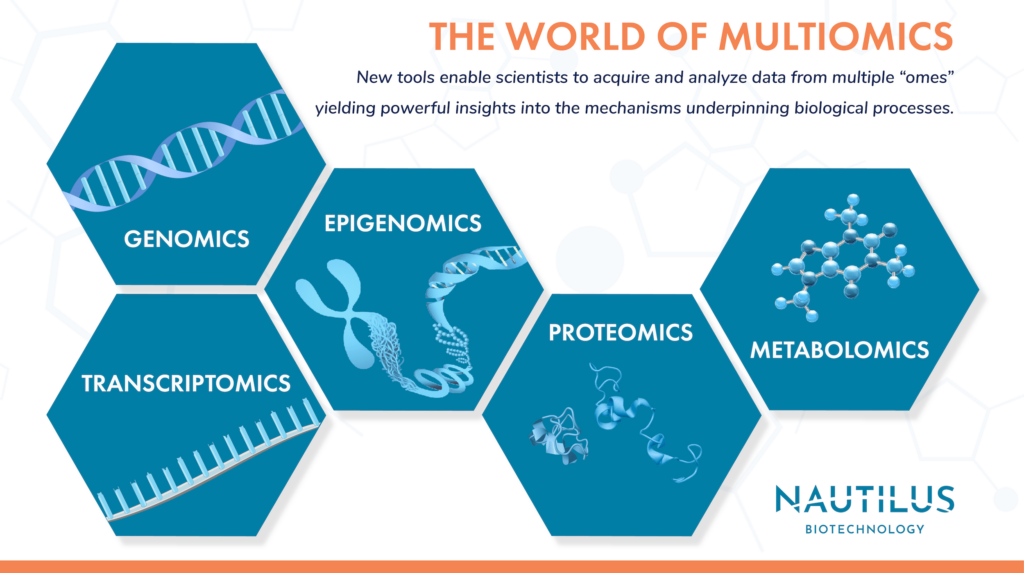
Multiomics is a holistic approach to biology that joins insights from genomics, proteomics, transcriptomics and other “omics.” Multiomics gives scientists a more complete understanding of cellular and organismal function. It provides researchers with a means to study processes that are too complex for any individual “ome” to capture on its own, and makes new advances in biology, medicine, and other fields possible.
For many years, scientists studied the genome gene-by-gene and the proteome protein-by-protein. Then “omics” technologies made it possible to study full collections of genes in the genome (genomics), proteins in the proteome (proteomics), and other biological molecules in a more holistic way.
Omics studies have revealed much, but scientists have come to realize they need to take things a step further. In a multiomic analysis, researchers study the various “omes” together, providing a much better understanding of the mechanisms underpinning biological processes and life itself.
The omes in multiomics
Though the power of multiomics comes from its breadth, studying individual omes can be a powerful way to approach a particular research question. Proteomics studies are revealing novel biomarkers for diseases and classifying cancers with unprecedented precision. Genome-wide association studies (GWAS), on the other hand, have uncovered genes contributing to depression, alcoholism and Alzheimer’s Disease by studying large quantities of genetic data from many people.
Nonetheless, individual omics approaches only consider one specific aspect of biology. To truly understand the biology of a human being or any other organism, researchers need to understand the full chain of multiomic events that lead to a particular outcome. Genes are transcribed into RNA. RNA is translated into proteins. These proteins serve as molecular machines that carry out tasks and provide structure to cells, organs, and organisms. Researchers must consider all these processes and the various omes associated with them to truly understand biology. By combining information from these omes into a multiomic perspective, researchers can begin to build a comprehensive view of organismal function.
Some of the omes that scientists consider when performing multiomic studies include:
- The proteome – The dynamic collection of all the proteins in a cell or organism
- The genome – The collection of the genes and other stretches of DNA in a cell or organism
- The transcriptome – The collection of all RNA molecules in a cell or organism
- The epigenome – The collection of modifications to DNA and proteins associated with DNA that alter how genes are expressed and to what extent they are expressed
- The metabolome – The collection of small molecules in a cell or organism
Combining comprehensive information from each ome using a multiomics approach can reveal previously hidden facets of biology. For example, scientists may see that a particular protein is more common in people with a certain type of cancer, but it could be tough to know exactly how that protein changes a cell’s state without information from metabolomics studies. Likewise, transcriptomics and epigenomics could show how changes in gene transcription or expression affect a protein’s abundance when coupled with proteomics. Furthermore, effective tests and drugs depend on the biology at each of these levels; understanding them more deeply provides more options to scientists and clinicians working to diagnose, treat, and cure disease.
Applications of multiomics
Multiomics has many applications across biology, and is increasingly used by researchers to probe important questions in human health and disease. The uses of multiomics are very broad, but, as a sampler, multiomics can:
- Help diagnose chronic kidney disease
- Identify druggable pathways in lung cancer
- Enable researchers to study fruit ripening.
Learn about these multiomics applications and more in our related blog post on the topic.
Improved multiomics requires new tools
We’ll discuss some of the techniques scientists use to study the various omes in the next post in this series, but, to fully realize the value of multiomics, we’ll need new tools, technologies, and practices.
The Nautilus Proteome Analysis Platform is one such enabling technology. It is designed to offer unparalleled sensitivity and dynamic range when measuring the complete proteome of any sample. Currently, proteomics platforms may only reveal 10 percent of a sample’s proteome. With the Nautilus platform, that’s expected to be closer to 95 percent.
Proteomics is a crucial link in the omics chain. We need every link to be comprehensive for the true promise of multiomics to emerge. With new technologies, we may get there soon.
Check out this episode of the Translating Proteomics Podcast to learn how we can leverage multiomics to study “Biology in Space and Time”
MORE ARTICLES


